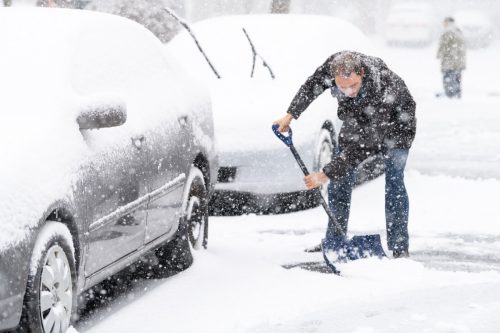“Extended Winter” May Keep Things Cold in These Regions, Meteorologists Predict

You don’t need to rely on Punxsutawney Phil’s shadow to tell you how much longer you’ll be bundled up this winter. Weather superstitions aside, meteorologists have actual data-based predictions to consider. In fact, AccuWeather just released its 2024 spring forecast for the U.S., and the amount of winter weeks left may depend on where you live. Read on to find out what parts of the country are expected to have an extended winter, and where you can look forward to an early spring.
RELATED: Polar Vortex Could Bring “Severe Winter Weather” to the U.S.—Here’s When.
Early Spring

Meteorological spring starts on March 1 instead of March 19, according to AccuWeather. And depending on where you live, you might feel the spring weather as soon as the month starts as well. AccuWeather’s meteorologists are predicting that “an early end to winter is possible in regions of the Northern tier.”
So if you live in Montana, North Dakota, South Dakota, Minnesota, Wisconsin, Michigan, and the northern parts of Wyoming, Nebraska, and Iowa, you may be able to swap out your winter wardrobe earlier in 2024.
RELATED: This Weekend’s “Largest Storm of the Season” Could Drench These Regions.
Extended Winter

But that early spring weather isn’t something everyone will get to experience—especially those in the Four Corners. If you live in New Mexico, the eastern half of Arizona, the southern part of Utah and Colorado, or the top western tip of Texas, you should expect an extended winter as we head into March.
According to AccuWeather meteorologists, this is where “winter’s chills could hang on longer than other regions.” Those living in these areas should expect spring temperatures to be two degrees or lower this year compared to historical averages.
RELATED: Meteorologists Say 2024 Will “Amplify Hurricane Activity”—Here’s Where.
Slow Transition

Some parts of the U.S. aren’t really going to experience a late winter or an early spring. Not exactly, at least. Meteorologists said states across the Southeastern part of the country can expect a slow transition during March.
So if you live in North Carolina, South Carolina, Georgia, Alabama, Mississippi, Louisiana, Tennessee, parts of Arkansas and Florida, you should be prepared for potential snowstorms through the first half of March before the weather pattern flips and the risk of significant snowfall diminishes.
“We may actually see a warmup in the second half of March across the eastern U.S.,” AccuWeather Veteran Meteorologist and Long-Range Forecaster Paul Pastelok said in a statement.
While the Northeast was not included under any of these categories, Pastelok did clarify that while there are possibilities for snow accumulation in the interior Northeast through April, meaningful snow accumulation likely won’t happen after mid-March for New York City, Philadelphia, or Washington, D.C.
Meteorologists are also predicting severe weather in the spring.

As we head further into spring, meteorologists are also predicting the possibility of severe weather in parts of the U.S. throughout April and May.
According to their forecast, an abundance of rainfall in April “will have the potential to trigger flooding from the Gulf Coast through the mid-Atlantic, including around Charlotte and Raleigh, North Carolina; Orlando and Tallahassee, Florida; Atlanta; and Richmond, Virginia.”
People in the Southeast should also start to prepare for the Atlantic hurricane season when we get toward the end of spring.
“It may not take much to get a tropical storm in May to form, especially around the Florida Peninsula and maybe southeast Texas where water [in the Gulf of Mexico] is warmer,” Pastelok warned.
Meanwhile, severe weather is likely to reignite through Tornado Alley in April and May as well, with damaging wind and hail predicted to be prevalent.
“May is when the tornadoes start to really come about,” Pastelok said.
RELATED: For more up-to-date information, sign up for our daily newsletter.